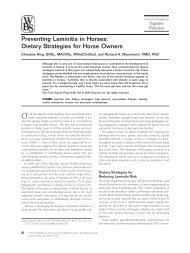Nutritional Secondary Hyperparathyroidism in the Horse
Nutritional Secondary Hyperparathyroidism in the Horse
Nutritional Secondary Hyperparathyroidism in the Horse
You also want an ePaper? Increase the reach of your titles
YUMPU automatically turns print PDFs into web optimized ePapers that Google loves.
52 Experimental <strong>Nutritional</strong> <strong>Secondary</strong> 1 lyperp~rathyroi~lis<strong>in</strong> <strong>in</strong> <strong>the</strong> IHorsc . . .<br />
v) Increase; serum phosphorus still <strong>in</strong>creas<strong>in</strong>g and hypocalcemia<br />
partly compensated for.<br />
vi) Decrease; hyperphosphatemia compensated for to a greater<br />
degree than hypocalcemia (with <strong>the</strong> exception of NSH 2).<br />
The regression l<strong>in</strong>es described similar diphasic <strong>in</strong>crease-decrease<br />
changes <strong>in</strong> all NSH horses. The magnitude and time periods were<br />
somewhat different <strong>in</strong> <strong>the</strong> horses, however. It should be emphasized<br />
that <strong>the</strong> <strong>in</strong>crease-demase phases <strong>in</strong> ser/cnl alkal<strong>in</strong>e phosphatase were <strong>in</strong>verse4<br />
related to <strong>the</strong> conti;rliioiu chanqes <strong>in</strong> semi<strong>in</strong> calciiiyN.<br />
3. Roentgenologic Observations<br />
A . Intrauital' Exa<strong>in</strong><strong>in</strong>atioii<br />
The results of <strong>the</strong> series of radiographs taken dur<strong>in</strong>g <strong>the</strong> course of<br />
<strong>the</strong> experiment are summarized <strong>in</strong> Table XVIII. Progressive radio-<br />
lucency was evident <strong>in</strong> <strong>the</strong> mandibles (Fig. 18) and maxillae. Rc-<br />
companied by this, a radiolucent miliary mottl<strong>in</strong>g which might also<br />
be described as a spongy or moth-eaten appearance developed. Pro-<br />
gressive loss of <strong>the</strong> lam<strong>in</strong>ae durae was seen. Subperiosteal resorption<br />
appeared <strong>in</strong> <strong>the</strong> ventrodorsal views of <strong>the</strong> mandible on <strong>the</strong>cortical bone<br />
lateral to <strong>the</strong> roots of <strong>the</strong> corner <strong>in</strong>cisor teeth. The characteristic changes<br />
<strong>in</strong> <strong>the</strong> metacarpi were endosteal roughen<strong>in</strong>g, radiolucent l<strong>in</strong>ear stria-<br />
tions <strong>in</strong> <strong>the</strong> cortex, and coarse trabeculation of <strong>the</strong> spongy bone at <strong>the</strong><br />
metaphyseal ends of <strong>the</strong> medullary cavity.<br />
The changes <strong>in</strong> <strong>the</strong> mandibles and maxillae were observed sooner<br />
and progressed at a more rapid rate than those <strong>in</strong> <strong>the</strong> metacarpus.<br />
Although <strong>the</strong> changes noted <strong>in</strong> <strong>the</strong> affected colts were identical, <strong>the</strong><br />
rates of change varied. NSH 2 showed <strong>the</strong> earliest change, NSJ-I 3<br />
next, and <strong>the</strong>n NSI-I 1. The degree of change <strong>in</strong> NSH 1 was less than<br />
that <strong>in</strong> NSH 2 or 3.<br />
It must be noted that <strong>the</strong> changes were <strong>in</strong>sidious and progressive,<br />
so that <strong>the</strong>y did not become strik<strong>in</strong>gly apparent from one month to <strong>the</strong><br />
next. However, when 4 or 5 monthly radiographs were reviewed, <strong>the</strong><br />
changes were obvious.<br />
Downloaded from<br />
vet.sagepub.com by guest on April 14, 2010



